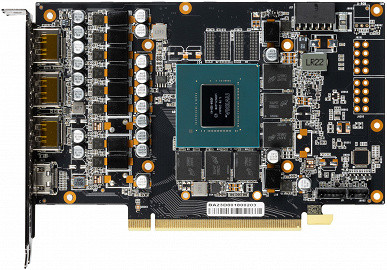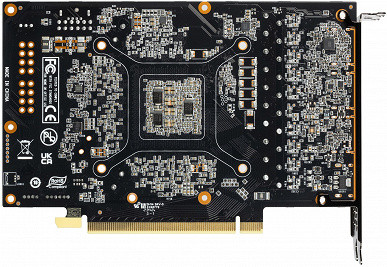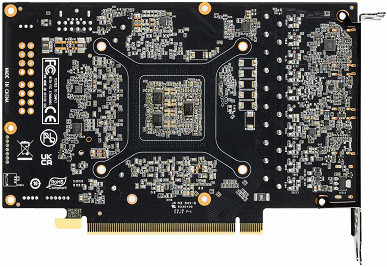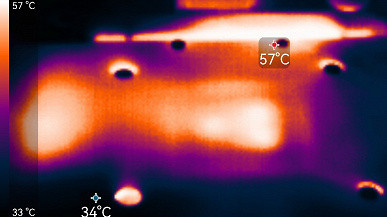General information about GeForce RTX 4070 Super
We recently reviewed the GeForce RTX 4080 Super, the third most recently released in the updated Super line of video cards. However, today we will pay attention to those models that appeared on the market earlier. Let's remember that in the fall of 2022, the first RTX 40 GPUs appeared — GeForce RTX 4090, GeForce RTX 4080 and GeForce RTX 4070. The latter, released last spring, offered an affordable solution with high performance, especially thanks to DLSS technology.
However, at CES in early 2024, Nvidia introduced three new models with the Super suffix: GeForce RTX 4070 Super, GeForce RTX 4070 Ti Super and GeForce RTX 4080 Super. These video cards added newness to the line before the next generation was released in the fall. Today we will take a closer look at the most affordable of the current generation Super models — the GeForce RTX 4070 Super, which is apparently of interest to potential buyers.
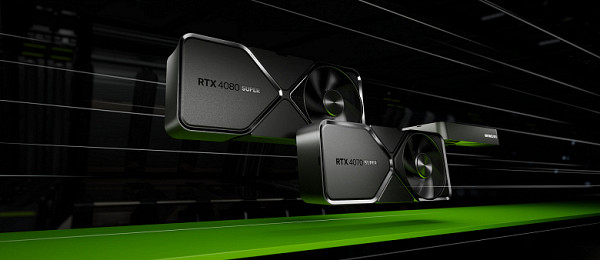
The GeForce RTX 4070 Super was introduced to the market earlier than the other two models — already on January 17, followed by the GeForce RTX 4070 Ti Super, and the GeForce RTX 4080 Super appeared at the end of the month. Despite the fact that we first looked at the more expensive option, we will now turn our attention to two earlier new products. Details about the configuration and prices for the new Super models have already been presented in our news, and now let's move on to the next review of the January release.
The GeForce RTX 4070 Super adds more power with additional stream processors over the regular GeForce RTX 4070, delivering better specs and higher performance for the same $599 MSRP. At the same time, the GeForce RTX 4070 remains on sale, dropping to $549. For most buyers, the GeForce RTX 4070 Super is the most attractive upgrade, given its affordable price and expected performance boost over the base model.
This model is a significant addition to the GeForce RTX 40 line, offering more than a 20% increase in execution cores compared to the GeForce RTX 4070 and even slightly ahead of the previous generation flagship, the GeForce RTX 3090, while maintaining lower power consumption. The GeForce RTX 4070 Super is recommended for enthusiasts who want new architecture and high performance without having to spend thousands of dollars. This GPU is optimal for gaming at 2560x1440 resolution at maximum settings, including ray tracing, although it may not always be suitable for 4K at the same parameters — however, with DLSS support, including the new generation of additional frames of the GeForce RTX 40 series, you can compensate for some limitations, especially in comparison with the flagship GeForce RTX 4090 without using DLSS. The graphics architecture of Ada Lovelace remains similar to Ampere, and both share many of the same features as the previous Turing and Volta architectures.
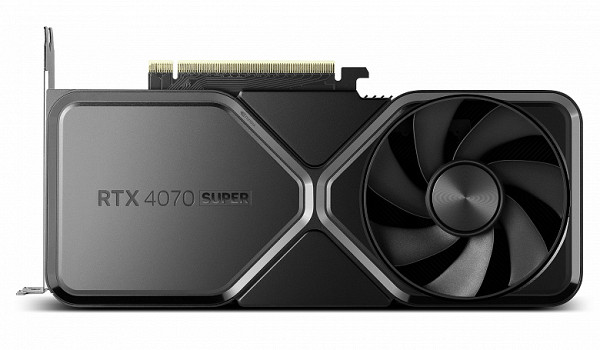
| GeForce RTX 4070 Super graphics accelerator | |
|---|---|
| Chip code name | AD104 |
| Production technology | 5 nm (TSMC 4N) |
| Number of transistors | 35.8 billion |
| Core area | 294.5 mm² |
| Architecture | unified, with an array of processors for stream processing of any type of data: vertices, pixels, etc. |
| DirectX hardware support | DirectX 12 Ultimate, supporting Feature Level 12_2 |
| Memory bus | 192-bit: 6 independent 32-bit memory controllers supporting GDDR6X memory |
| GPU frequency | up to 2475 MHz |
| Computing blocks | 56 (out of 60) streaming multiprocessors, including 7168 (out of 7680) CUDA cores for INT32 integer and FP16/FP32/FP64 floating point calculations |
| Tensor blocks | 224 (out of 240) tensor cores for matrix calculations INT4/INT8/FP16/FP32/BF16/TF32 |
| Ray tracing blocks | 56 (out of 60) RT cores for calculating the intersection of rays with triangles and BVH bounding volumes |
| Texturing blocks | 224 (out of 240) texture addressing and filtering units with support for FP16/FP32 components and support for trilinear and anisotropic filtering for all texture formats |
| Raster Operation Blocks (ROPs) | 10 wide ROP blocks of 80 pixels with support for various anti-aliasing modes, including programmable and for FP16/FP32 frame buffer formats |
| Monitor support | HDMI 2.1 and DisplayPort 1.4a support (with DSC 1.2a compression) |
| GeForce RTX 4070 Super graphics card specifications | |
|---|---|
| Core frequency | 1980/2475 MHz |
| Number of universal processors | 7168 |
| Number of texture blocks | 224 |
| Number of blending blocks | 80 |
| Effective memory frequency | 21 GHz |
| Memory type | GDDR6X |
| Memory bus | 192 bit |
| Memory | 12 GB |
| Memory Bandwidth | 504 GB/s |
| Compute Performance (FP32) | up to 35.5 teraflops |
| Theoretical maximum fill rate | 198 gigapixels/s |
| Theoretical texture sampling rate | 554 gigatexels/s |
| Tire | PCI Express 4.0 x16 |
| Connectors | according to the manufacturer's choice |
| Energy consumption | up to 220 W |
| Additional food | one 16-pin connector |
| Number of slots occupied in the system case | according to the manufacturer's choice |
| Recommended price | $599 |
The name of the new graphics card, GeForce RTX 4070 Super, follows the tradition of naming improved models from Nvidia, which appear about a year after the basic versions of video cards. This model is a significant improvement over the original GeForce RTX 4070, and its Super suffix makes sense. Filling the gap between the GeForce RTX 4070 and GeForce RTX 4070 Ti, the new product promises higher performance and proximity to the Ti version.
The Super suffix in this context indicates an increase in the computing power of the GPU by adding active units and increasing their frequency. Unlike the base model GeForce RTX 4070, which had limited specifications, the GeForce RTX 4070 Super comes closer to the Ti version, equipped with 56 multiprocessors and 48 MB of cache, which makes it close in characteristics to the GeForce RTX 4070 Ti.
With a suggested price of $599, the GeForce RTX 4070 Super remains in the same price range as its predecessor, the GeForce RTX 4070. However, the base model GeForce RTX 4070 has received an official price cut of $50, now set at $549. With market prices close to listed, the GeForce RTX 4070 Super appears to be an attractive upgrade with a good price-performance ratio.
Compared to its competitor, AMD's Radeon RX 7800 XT, the GeForce RTX 4070 Super offers significantly higher performance and efficiency even under rasterized conditions. Hardware ray tracing, which has become an important criterion, also benefits the new Nvidia model. These advantages make the GeForce RTX 4070 Super an attractive choice, despite possible price adjustments from the competitor.
It is noted that the choice of video memory in the GeForce RTX 4070 Super, equal to 12 GB, corresponds to the intended use of the card at a resolution of 2560x1440. This amount of video memory provides good performance in most use cases, although some users may feel that 16GB would be more ideal. However, for most tasks and games at the specified resolution, 12 GB of video memory cope quite well.
The Founders Edition presented by Nvidia retains the design of the reference versions, with a black aluminum body and a cooling system based on a radiator with four copper heatpipes and two fans. The power system has also been updated to a 16-pin connector, ensuring reliable power connections. With an increase in maximum power consumption to 220 W, the energy efficiency of the GeForce RTX 4070 Super has become higher compared to its predecessors and competitors.
As such, the GeForce RTX 4070 Super represents a significant upgrade to the company's graphics card lineup, offering outstanding performance in its price segment and becoming an attractive option for enthusiasts focused on gaming at 2560x1440 resolution.
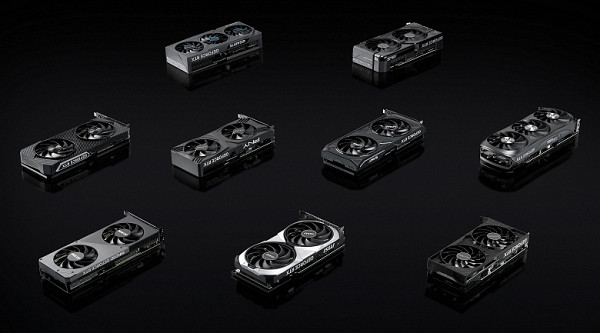
Nvidia's partners quickly introduced and released to the market various versions of GeForce RTX 4070 Super video cards with their own designs. These options include both overclocked models and those equipped with improved cooling and power systems, including the use of two or three fans. Products from various manufacturers such as Asus, Colorful, Gainward, Galaxy, Gigabyte, Innovision 3D, MSI, Palit, PNY, Zotac are already available in various configurations, giving consumers a variety of options to choose from.
Architecture Features

Unlike the GeForce RTX 4070 Ti, which was based on the full version of the AD104 GPU, the new Super model uses a slightly trimmed version of this chip. Its composition includes five GPC computing clusters, 28 TPC texture processing clusters and 56 SM streaming multiprocessors. The total number of CUDA cores is 7168, with 56 RT cores for hardware acceleration of ray tracing, 224 tensor cores, as well as 224 TMUs and 80 ROPs. The operating frequency of the GPU varies from a base frequency of 1980 MHz to a turbo frequency of 2475 MHz.
The characteristics of the GeForce RTX 4070 Super are almost identical to those presented in the GeForce RTX 4070 Ti, with the exception of minor differences in the number of multiprocessors and related units. This factor provides more than a 20% increase in performance compared to the GeForce RTX 4070, not taking into account the additional ROP units and the expanded L2 cache. The memory subsystem remains the same as the GeForce RTX 4070 Ti, including 7168 KB L1 cache and 48 MB L2 cache. The effective GDDR6X video memory frequency is 21 GHz, providing 504 GB/s bandwidth on a 192-bit bus.
However, the main attention is drawn to the limitation of video memory to 12 GB, which may cause some doubts among consumers. Despite this, thanks to the large L2 cache, this model successfully copes with the limitations of a narrow bus. Considering the price starts at $600, this amount of video memory remains acceptable, especially for games at 2560x1440 resolution. Overall, the GeForce RTX 4070 Super provides excellent value for money and can meet the needs of most users for gaming and professional applications.
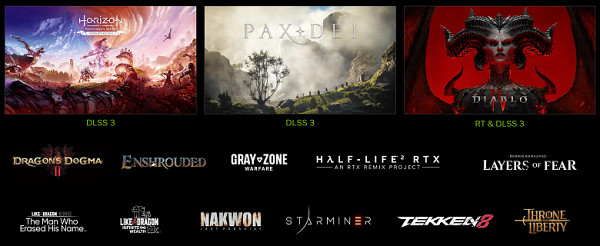
All architectural improvements to the Ada Lovelace family have been reviewed in detail, including changes to the RT cores of the new architecture. These changes include the introduction of the Opacity Micromap Engine and Displaced Micro-Mesh Engine hardware units, as well as an additional scheduler for Shader Execution Reordering. All of these innovations help improve the efficiency of hardware ray tracing.
The DLSS technology was also examined in detail, which is not just a resolution scaling technology, but also has the ability to insert additional frames based on information from existing ones. This increases the frequency and smoothness of video footage, and also optimizes complex ray tracing through information accumulation and reconstruction. DLSS technology in version 3.5 supports frame generation and ray reconstruction. Currently, it represents a more advanced and effective option compared to similar solutions from competitors.
These innovations in graphics scaling and processing are becoming integral to improving performance in games and professional applications. The use of such technologies is already becoming an active trend, improving the quality of graphics and providing a smoother gaming experience. Games with advanced graphics and ray tracing, such as Alan Wake 2 and Cyberpunk 2077, become more accessible thanks to these tools, which provide high-quality graphics while using resources more efficiently.
In the future, we can expect that the use of such technologies will become even more widespread, and disabling such tools may become impossible in light of their importance for high performance and graphics quality.
| GeForce RTX 4070 | GeForce RTX 4070 Super | GeForce RTX 4070 Ti | GeForce RTX 4070 Ti Super | GeForce RTX 4080 | GeForce RTX 4080 Super | GeForce RTX 4090 | |
|---|---|---|---|---|---|---|---|
| GPU | AD104 | AD104 | AD104 | AD103 | AD103 | AD103 | AD102 |
| Number of SM multiprocessors | 46 | 56 | 60 | 66 | 76 | 80 | 128 |
| Number of CUDA cores | 5888 | 7168 | 7680 | 8448 | 9728 | 10240 | 16384 |
| Number of TMUs | 184 | 224 | 240 | 264 | 304 | 320 | 512 |
| Number of ROP blocks | 64 | 80 | 80 | 96 | 112 | 112 | 176 |
| L2 cache volume, MB | 36 | 48 | 48 | 48 | 64 | 64 | 72 |
| Base frequency, MHz | 1920 | 1980 | 2310 | 2340 | 2205 | 2295 | 2235 |
| Turbo frequency, MHz | 2475 | 2475 | 2610 | 2610 | 2505 | 2550 | 2520 |
| Texturing speed, Mtex/s | 455 | 554 | 626 | 689 | 762 | 816 | 1290 |
| Fill rate, Mpix/s | 158 | 198 | 209 | 251 | 281 | 286 | 444 |
| Memory capacity, GB | 12 | 12 | 12 | 16 | 16 | 16 | 24 |
| Memory bus, bit | 192 | 192 | 192 | 256 | 256 | 256 | 384 |
| Memory frequency, GHz | 21 | 21 | 21 | 21 | 22.4 | 23 | 21 |
| PSP, GB | 504 | 504 | 504 | 672 | 736 | 736 | 1008 |
| Energy consumption, W | 200 | 220 | 285 | 285 | 320 | 320 | 450 |
| Price, $ | 599 | 599 | 799 | 799 | 1199 | 999 | 1599 |
The GeForce RTX 4070 Super is significantly behind the GeForce RTX 4080, especially in the number of functional units, the amount of video memory and the width of its bus. This is due to the AD103's larger and more powerful GPU compared to the AD104. Compared to the GeForce RTX 4070, the new product has 22% more execution units operating at approximately the same frequency, as well as 10% higher maximum power consumption, which leads to a significant increase in performance.
According to the specifications, the GeForce RTX 4070 Super should be more than 20% faster than the regular GeForce RTX 4070, making it an attractive option at a similar price. In real-world games, it shows about a 15%-16% performance improvement over the base GeForce RTX 4070 and a slight slowdown (about 7%) compared to the more powerful GeForce RTX 4070 Ti. Despite the theoretical differences caused by different maximum power consumption limits, the new product represents an attractive proposition in terms of the combination of characteristics.
The disadvantages of the GeForce RTX 4070 Super can be considered a narrow 192-bit video memory bus and only 12 GB of video memory. For now, 12 GB is sufficient, especially given the large L2 cache in the Ada architecture, but this may require additional attention in the future.
GeForce RTX 4070 Super video cards appeared on the market on January 17. They tend to quickly approach MSRP, although they can currently sell for $50-$100 more, depending on the brand and model. The GeForce RTX 4070 and GeForce RTX 4070 Super provide similar price-performance ratios, but the new one outperforms the base model by about 15%-16%, offering great performance at a great price.
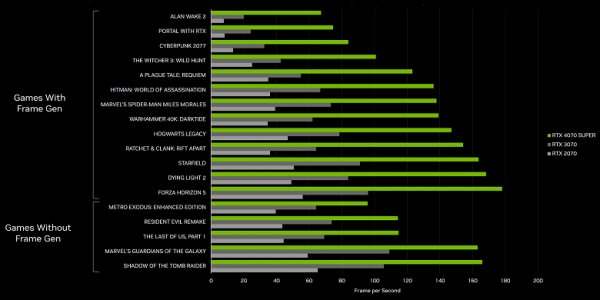
According to tests conducted by Nvidia, the GeForce RTX 4070 Super is significantly superior to its predecessors from the previous two generations of video cards. Compared to the GeForce RTX 30th generation, the new product provides up to 50% performance improvement, while increasing energy consumption by only 10%. This results in a higher price/performance ratio, making the GeForce RTX 4070 Super an attractive choice.
A comparison with the Radeon RX 7800 XT shows that the GeForce RTX 4070 Super outperforms its competitor in games without ray tracing, which is Nvidia's goal. This is especially noticeable at a resolution of 2560x1440 at maximum graphics settings. Between the GeForce RTX 4070 and GeForce RTX 4070 Super, it's better to choose the latter, as it provides a significant performance boost for a small additional cost. However, both video cards lag behind the GeForce RTX 4080 by about 30%.
The GeForce RTX 4070 Super demonstrated excellent results in ray tracing, even surpassing the Radeon RX 7900 XT and Radeon RX 7900 XTX. However, video memory limitations (12 GB) and a narrow 192-bit bus may become apparent in complex scenes at 4K resolution without the use of DLSS/FSR technologies. For professional digital content creation tasks such as rendering in Blender Cycles, Redshift, V-Ray and others, the GeForce RTX 4070 Super delivers strong performance, making it a value-for-money choice.

The capabilities of working with video data on the GeForce RTX 4070 Super video card remain very significant, despite the differences from the flagship model. The eighth generation of specialized hardware encoder NVEnc has acquired support for video encoding in AV1 format. It's important to note that the AV1 encoder on the Ada chip is 40% to 50% more efficient than the H.264 encoder found in previous GPU models. Support for the AV1 format opens up the possibility of increasing the resolution of the video stream when streaming from 1080p to 1440p at the same bitrate.
However, unlike older Ada GPU models, the GeForce RTX 4070 Super has several differences. The stripped-down version of the GPU includes two disabled TPC clusters and several inactive execution units. Against this background, in the Super model one of the two hardware video stream encoders NVEnc is deactivated, unlike the GeForce RTX 4070 Ti, where both are active. This results in a significant lag in overall video encoding performance—only half the performance of more powerful Ada GPUs that have two active encoders. This reduces the ability to encode 8K video data at 60 FPS or four 4K video streams at 60 FPS.
However, the video card retains the fifth-generation NVDec hardware decoder first introduced in the Ampere architecture. This decoder supports hardware decoding of video data in various formats, including MPEG-2, VC-1, H.264 (AVCHD), H.265 (HEVC), VP8, VP9 and AV1. Full support for decoding video data at 8K resolution at 60 FPS also remains on the list of features.
Palit GeForce RTX 4070 Super Dual 12 GB video card
Palit Microsystems, operating under the Palit brand, was established in 1988 in the Republic of China (Taiwan). The company's head office is located in Taipei, Taiwan, with a major logistics center in Hong Kong. An additional office responsible for sales in Europe is located in Germany. The company's factories are located in China. Palit has been present on the Russian market since 1995, starting its journey with the sales of nameless products known as Noname. The Palit brand began to be applied to products only after 2000. In 2005, the company acquired the Gainward brand and assets following the bankruptcy of that company, which led to the formation of the Palit Group holding company. Another office was opened in Shenzhen, focused on sales in China. Several additional brands and brands are also concentrated within the Palit Group.
The object of this study is the commercially produced Palit GeForce RTX 4070 Super Dual video card with 12 GB of memory and a 256-bit GDDR6 bus.
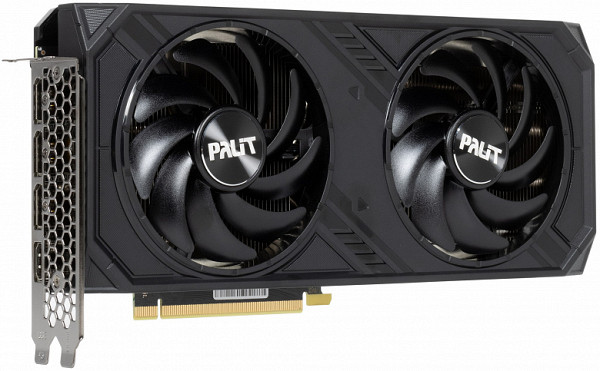
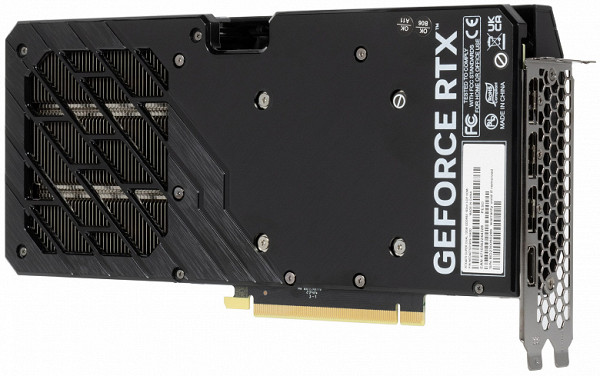
| Palit GeForce RTX 4070 Super Dual 12 GB 256-bit GDDR6 | ||
|---|---|---|
| Parameter | Meaning | Nominal value (reference) |
| GPU | GeForce RTX 4070 Super (AD104) | |
| Interface | PCI Express x16 4.0 | |
| GPU operating frequency (ROPs), MHz | 2475(Boost)—2825(Max) | 2475(Boost)—2760(Max) |
| Memory operating frequency (physical (effective)), MHz | 2625 (21000) | 2625 (21000) |
| Memory bus width, bits | 192 | |
| Number of computational units in the GPU | 56 | |
| Number of operations (ALU/CUDA) in block | 128 | |
| Total number of ALU/CUDA blocks | 7168 | |
| Number of texturing units (BLF/TLF/ANIS) | 224 | |
| Number of rasterization units (ROP) | 80 | |
| Number of Ray Tracing blocks | 56 | |
| Number of tensor blocks | 224 | |
| Dimensions, mm | 270×128×40 | 300×130×55 |
| Number of slots in the system unit occupied by a video card | 2 | 3 |
| PCB color | black | black |
| Peak power consumption in 3D, W | 219 | 225 |
| Power consumption in 2D mode, W | 35 | 35 |
| Energy consumption in sleep mode, W | eleven | eleven |
| Noise level in 3D (maximum load), dBA | 32.9 | 31.0 |
| Noise level in 2D (video viewing), dBA | 18.0 | 18.0 |
| Noise level in 2D (idle), dBA | 18.0 | 18.0 |
| Video outputs | 1×HDMI 2.1, 3×DisplayPort 1.4a | 1×HDMI 2.1, 3×DisplayPort 1.4a |
| Multiprocessor support | No | |
| Maximum number of receivers/monitors for simultaneous image output | 4 | 4 |
| Power: 8-pin connectors | 0 | 0 |
| Power: 6-pin connectors | 0 | 0 |
| Power: 16-pin connectors | 1 | 1 |
| Weight of the card with delivery set (gross), kg | 1.1 | 2.0 |
| Card weight (net), kg | 0.75 | 1.2 |
| Maximum resolution/frequency, DisplayPort | 3840×2160@144 Hz, 7680×4320@60 Hz | |
| Maximum resolution/frequency, HDMI | 3840×2160@144 Hz, 7680×4320@60 Hz |
Memory
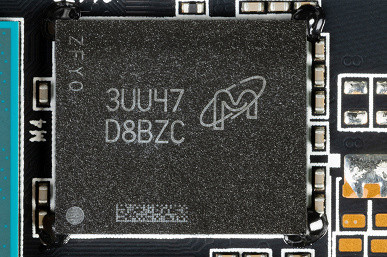
The graphics card is equipped with 12 GB of GDDR6X SDRAM, located on the front side of the printed circuit board in the form of 6 chips of 16 Gbit each. Memory chips manufactured by Micron (model MT61K512M32KPA-21/D8BZC) are designed to operate at a nominal frequency of 2625 (21000) MHz.
Card features and comparison with Palit GeForce RTX 4070 Ti JetStream (12 GB)
We are comparing this video card with a slightly higher-end model from the same manufacturer, since the GeForce RTX 4070 Super is actually closer to a stripped-down version of the GeForce RTX 4070 Ti than the GeForce RTX 4070. Please note that both printed circuit boards (PCBs) are completely identical and are almost identically equipped (with the exception of one GPU power phase in the GeForce RTX 4070 Super model, as well as differences in the element base).
The graphics core is labeled AD104-350, and its release date falls on the 44th week of 2023. While the GeForce RTX 4070 Ti model has a core marking of “-400/401”, and the GeForce RTX 4070 has a “-320” core.
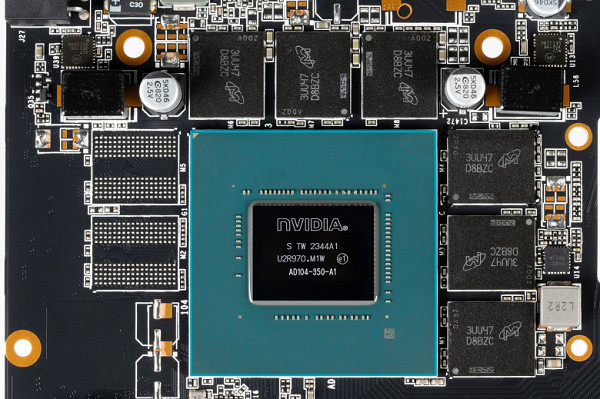
On the right side of the card you can see connectors similar to the 8-pin power connectors. However, they are designed to connect powerful external fans in systems using professional versions of similar video cards. It is worth noting that the same GPUs are used for gaming and professional video cards, and the differences can only be in the amount of memory, the configuration of working units, and also in the software.
The total number of power phases on the Palit card in question is 10 (8+2).

On the power diagram, the phases responsible for supplying energy to the core are marked in green, and the phases related to powering the memory are marked in red. It is important to note that all pulse width modulation (PWM) controllers are located on the back of the PCB.
The uP9512R PWM controller, manufactured by uPI Semiconductor, is responsible for controlling the 8 phases of the core power supply. This controller is designed to support up to 12 phases maximum.
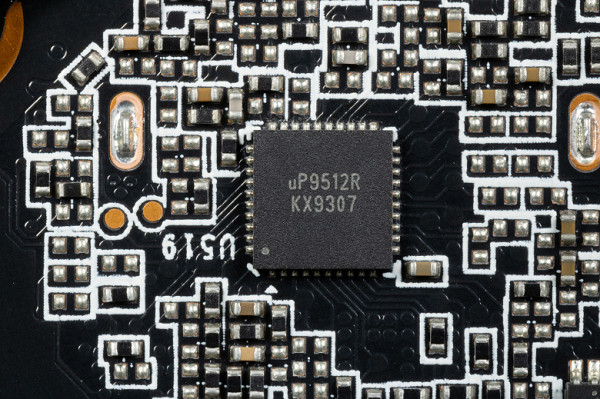
The power supply for the memory chips is controlled by the uP9529Q PWM controller (uPI Semiconductor).
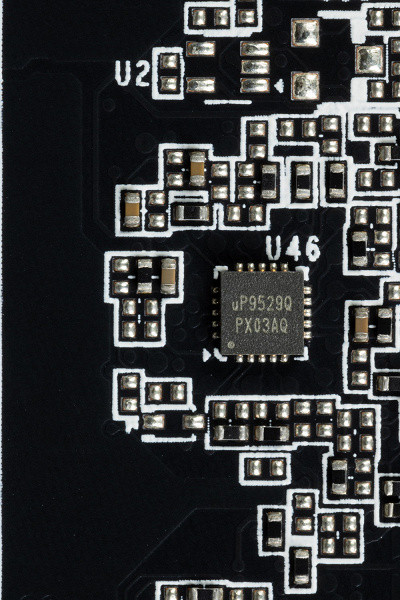
For the power converter, traditionally used in all Nvidia video cards, DrMOS transistor assemblies are used. This model uses NCP302150 components from On Semiconductor. Each of these assemblies is rated for a maximum current of up to 50 A.
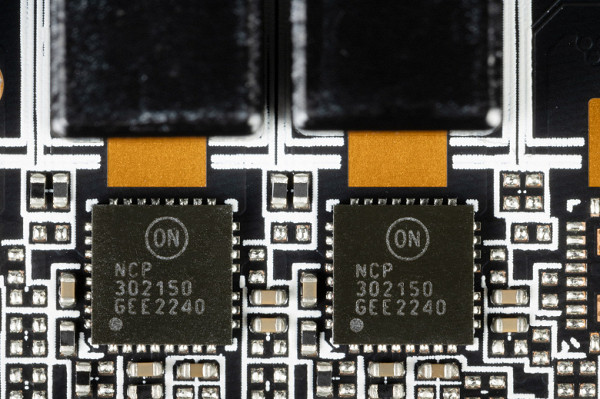
Also on the back of the board there is an NCP45491 (On Semi) controller, which is responsible for monitoring the card (monitoring voltages and temperatures).
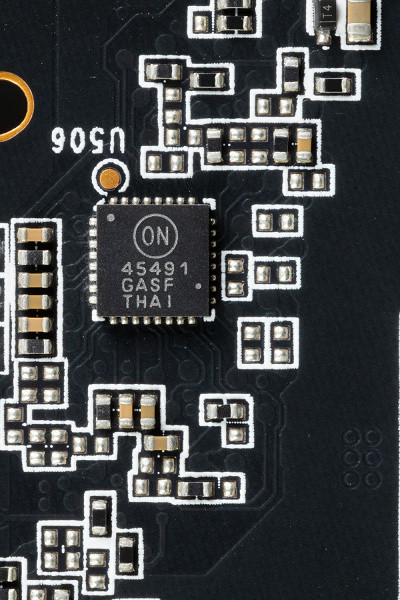
The video card is equipped with a simple backlight, which is controlled via the GPU and therefore does not require a separate dedicated controller.
Standard core and memory frequencies correspond to reference values, although the maximum core frequency is slightly higher than the reference value.
The power consumption of the Palit card in tests reaches 219 W. There is no way to increase the power limit on this card, so I didn't experiment with manual overclocking.
Power for the Palit card is supplied via a 16-pin PCIe 5.0 connector (12VHPWR).

The card is supplied with an adapter for such a connector from two ordinary 8-pin ones (well known to everyone).
Despite the relatively low power consumption and low load on the adapter, it is recommended to use full ATX 3.0 power supplies with a 12VHPWR connector and a cable providing 16 pins for new generation video cards.
Let us note the standard dimensions of this card, which, especially in thickness (4 cm), are modest even at the moment. As a result, the video card occupies only 2 slots in the system unit.

It is important to note that none of the versions of the GeForce RTX 4070 supports multi-graphics configuration via SLI technology; there is no special connector on the top end for this purpose.
The functionality of the card is controlled using the proprietary Thunder Master utility. Although the latest version of the program, 4.14, was released before the release of the Super series and can recognize the GeForce RTX 4070 Super as a GeForce RTX 4070, all settings remain active and workable.
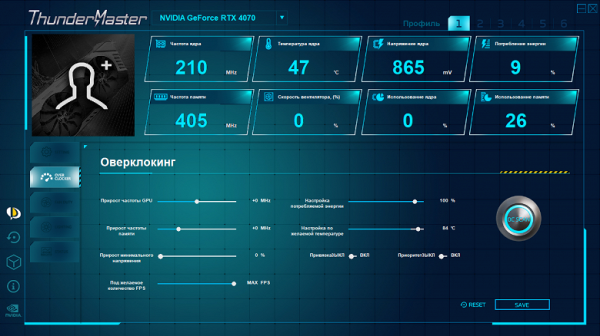
The overclocking panel allows you to adjust card frequencies and also set auto overclocking

Fan control panel, they can be controlled separately
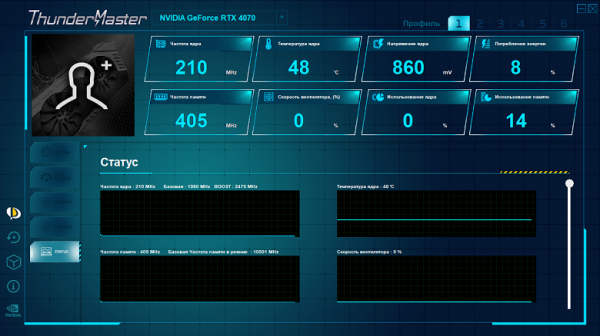
Card Status Dashboard
Heating and cooling
The use of a cooler built according to the traditional principle of through-blowing of the tail part of the radiator is noted. The cooling system includes a multi-section nickel-plated radiator with heat pipes. Heat pipes serve to effectively distribute heat over the surface of the radiator.
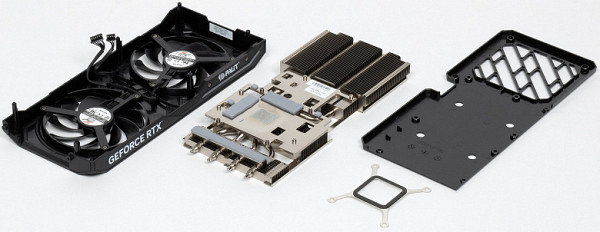
The heat pipes are connected to a large nickel-plated copper plate, which effectively cools both the GPU and memory chips (via thermal pads). An additional soleplate on the heatsink is designed to cool the VRM power converters.
The back plate serves as PCB protection and is part of the overall design concept.

Above the radiator there is a casing with two fans with a diameter of 100 mm, operating at a consistent speed (this value can be adjusted through the ThunderMaster program). When the graphics card is under low load, the fans stop if the GPU temperature drops below 50 degrees and the memory chip temperature drops below 80 degrees. In this mode, the cooling system is completely silent. When you start the computer, the fans start working, but after loading the video driver they turn off. Below is a video on this topic.
Temperature monitoring:

After two hours of testing under maximum load, the maximum core temperature did not exceed 75 degrees (the highest point was 89 ° C), and the temperature of the memory chips reached 78 degrees. These results are satisfactory for video cards of this level, taking into account the compactness of the cooling system. The card's power consumption in tests reached 219 W, which remains within safe operation limits. We remind you that the safe temperature limit for GDDR6X memory is 105 °C.
We recorded and sped up the 8-minute warm-up process by 50 times.
The maximum heating was observed in the central part of the PCB, as well as near the PCIe connector.
Noise
Noise measurements were carried out in a room that provides sound insulation and suppression of reverberations. The system unit used to measure video card noise does not contain fans and is not a source of mechanical noise. The background noise level was 18 dBA, representing the noise level in the room and the level of the sound level meter itself. Measurements were taken at a distance of 50 cm from the video card, at the level of its cooling system.
Measurement modes included:
- Idle mode in 2D: operation of the Internet browser, Microsoft Word application and several Internet communicators.
- 2D mode with movie viewing: using SmoothVideo Project (SVP) with hardware decoding and insertion of intermediate frames.
- 3D mode with maximum load on the video card: running the FurMark test.
The noise level was assessed using the following scale:
- Less than 20 dBA: relatively silent.
- 20–25 dBA: very quiet.
- 25–30 dBA: quiet.
- 30–35 dBA: clearly audible.
- 35–40 dBA: loud, but tolerable.
- More than 40 dBA: very loud.
In idle mode in 2D, the temperature did not exceed 35 ° C, the fans did not work, and the noise level was consistent with the background — 18 dBA.
When watching a movie with hardware decoding, there were no significant changes.
At maximum 3D load, temperatures reached 75/89/78 °C (core/hot spot/memory). The accelerator fans rotated up to 1847 rpm, and the noise level was 32.9 dBA — clearly audible, but not yet loud. The noise spectrogram looks quite smooth, without pronounced peaks that could cause discomfort.
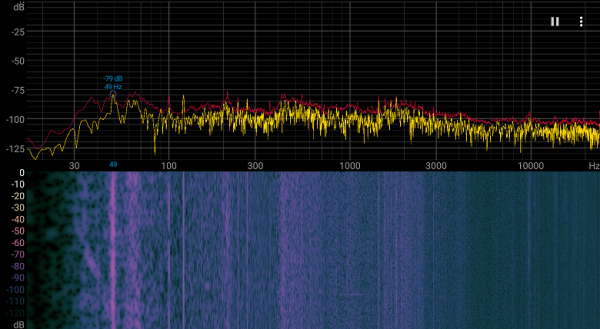
Do not forget that the heat generated by the card remains inside the system unit, so using a case with good ventilation is highly desirable.
Backlight

The card has a very modest backlight in the form of a broken line at the top end of the card. As some “consolation” for fans of modding things, Palit offers the opportunity to modify the CO casing using the “Maker” concept.
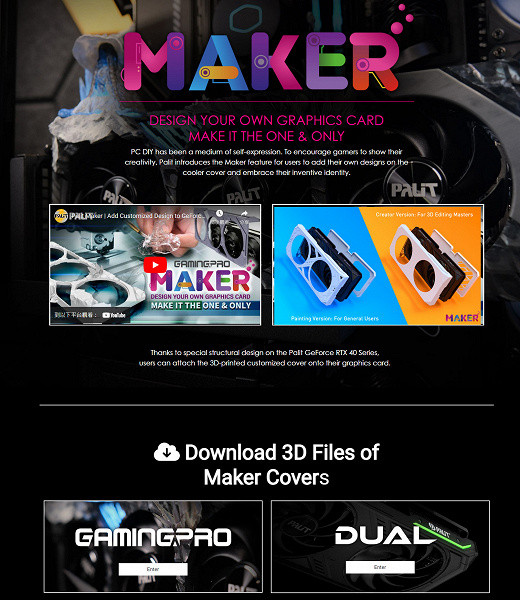
Owners of GeForce RTX 40 series GamingPro and Dual video cards have the opportunity to download various casing designs from the official Palit website. In addition, users can add custom elements, make changes to templates, be creative, and save the result as projects. The resulting designs can then be 3D printed or printed on your own printer, then painted and installed in place of the standard casing (which is snapped on).
The backlight modes, including turning it off, are controlled by the same ThunderMaster utility. There are not many backlight modes, but they are extremely easy to use.

Delivery and packaging
In addition to the card, the package includes only a power adapter (we talked about it earlier).
Testing: synthetic tests
This is a free video card from Nvidia. стандартных частот в нашем наборе синтетических тесstов. Набор тестов постоянно совершенствуется, иногда добавляются новые тесты, а устаревшие постепенно убираются. If you want to use it, you can take it into account. lodging равлять autoram.
Series of new benchmarks Developed technology разрешения: DLSS, FSR и XeSS. In addition to the available polytechnics 3DMark, такие к ak Time Spy, Port Royal, DX Raytracing, Speed Way and drugs. Version DirectX 11 and 12, available and integrated SDK Avali necorektanyye результаты.
Synthetic tests and video recordings:
- GeForce RTX 4070 Super стандартными parameters
- GeForce RTX 4070 Ti стандартными parameters
- GeForce RTX 4070 with standard parameters
- GeForce RTX 3090 with standard parameters
- Radeon RX 7900 XT with standard parameters
- Radeon RX 7800 XT with standard parameters
GeFor is a new version of GeFor ce RTX 4070 Super and available versions and configurations Radeon .
Tests 3DMark Vantage
Many ways to analyze analysis тесты из пакета 3DMark Vantage, available and available аспекты, отсутствующие в более современных тестах. Features: DirectX 10 and other media channels т свою актуальность, позволяя нам извлекать полезные выводы при анал изе результатов новых videokart.
Feature Test 1: Texture Fill
Первый тест измеряет производительность блоков текстурных выборо k. В нем осуществляется заполнение прямоугольника значениями, считыв аемыми из небольшой текстуры с использованием многочисленных текст урных кординат, изменяющихся каждый кадр.

The performance of AMD and Nvidia graphics cards in Futuremark's texture test is usually quite high, and the results of this test are often close to the corresponding theoretical parameters. However, sometimes performance may be slightly reduced for certain GPUs. Overall, the full version of the AD104 GPU shows strong performance in this test, and the RTX 4070 Super is significantly ahead of the RTX 4070 by more than 20%, which is in line with the theoretical difference between the two.
The RTX 4070 Ti, which has more texture units and a higher maximum power consumption level, is also slightly faster, although the difference in texturing speed is not as great. Comparing the video card we are considering today with competitors from AMD gives an advantage in favor of GeForce, despite the fact that previous generations of AMD were stronger in this test. However, the effective texturing speed of the new Radeon family has decreased slightly, and Nvidia's similarly priced solutions have caught up and in some cases even outperformed them. Thus, the RTX 4070 Super has even caught up with the Radeon RX 7900 XT, not to mention the competitor’s younger model.
Feature Test 2: Color Fill
The second test measures the fill rate. It uses a simple pixel shader that does not limit performance. The interpolated color value is written to an off-screen buffer using alpha blending. This test uses the 16-bit FP16 off-screen buffer often used in HDR-rendered games, making it quite state-of-the-art.

Results of the second subtest 3DMark Vantage: Color Fill
The results of the second subtest of 3DMark Vantage, which measures the performance of ROP units without taking into account the amount of video memory bandwidth, focuses on the performance of the ROP subsystem. In this test, the GeForce RTX 4070 Super shows a significant improvement over the base RTX 4070, which is understandable given the quarter difference in ROP speed. The RTX 4070 Ti shows another slight increase, although the number of ROP units remains the same as the model under review.
However, Nvidia's results pale in comparison to the performance of its competitor AMD. All Nvidia video cards in this test are inferior to the Radeon RX 7900 XT, which is twice as good. However, AMD's RX 7800 XT, a closely priced competitor, is more competitive than the GeForce in question. In the area of peak scene fill rate, GeForce video cards have always lagged behind the competition, which is confirmed by the results of this test.
Feature Test 3: Parallax Occlusion Mapping
The third feature test, Parallax Occlusion Mapping, is of particular interest, since this technique has been used in games for a long time. The test involves complex geometry using the Parallax Occlusion Mapping technique, which emulates 3D shapes. It involves resource-intensive ray tracing operations and the use of a high-resolution depth map. The surface is also shaded using a complex Strauss algorithm. This test puts a lot of stress on the GPU, including lots of ray tracing texture fetches, dynamic branching, and complex Strauss-style lighting calculations.
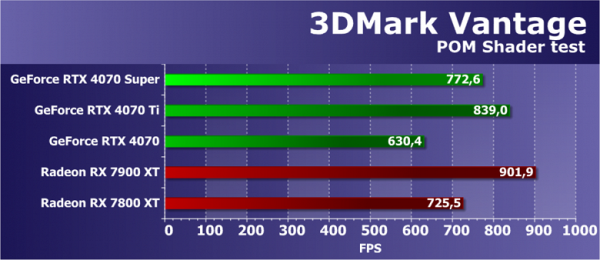
3DMark Vantage benchmark results are not determined solely by math speed, branching efficiency, or texture fetch speed. They depend on several parameters simultaneously, including GPU balance and the efficiency of complex shaders. This test is an important tool because its results often correlate with performance in real-world gaming tests.
This is where both math and texture performance play a critical role. In the 3DMark Vantage test, the new GeForce RTX 4070 Super performed as expected, outperforming the base RTX 4070 by about 23%, which is the theoretical difference between the two. The RTX 4070 Ti model on the same GPU also turned out to be a little faster, which is logical. It is noticeable that the new product has taken an intermediate position on the diagram between competitors, such as the Radeon RX 7900 XT and RX 7800 XT video cards, closer to the latter. This trend will likely continue in games without ray tracing.
Of particular interest is the Fourth test, which evaluates physical interactions (fabric simulation) using the GPU. Vertex simulation is used, combining vertex and geometry shaders with multiple passes. Stream out is used to transfer vertices between simulation passes. This test allows you to evaluate the performance of vertex and geometry shaders, as well as stream out speed.
Feature Test 4: GPU Cloth
The fourth test is interesting because it calculates physical interactions (fabric simulation) using the GPU. Vertex simulation is used, using the combined work of vertex and geometry shaders, with several passes. Use stream out to transfer vertices from one simulation pass to another. Thus, the execution performance of vertex and geometry shaders and the stream out speed are tested.

Rendering speed in this test depends on several parameters, with the main influencing factors being geometry processing performance and geometry shader execution efficiency. At first glance, the strengths of Nvidia chips should have appeared, but we are faced with clearly incorrect results in this test. Such problems are not limited to just GeForce graphics cards — Radeon graphics cards have also fallen into the same situation over time. AMD's new drivers perform poorly and all GPUs seem to report incorrect data in this test, which is not as expected. The problem is likely in the drivers, which are no longer optimized for this outdated test suite.
Feature Test 5: GPU Particles
This test evaluates physics-based effects simulations based on particle systems calculated using the GPU. A vertex simulation is used, where each vertex represents an individual particle. Stream out is also used for the same purpose as in the previous test. The test calculates several hundred thousand particles, each one is animated separately, and their collisions with the height map are also taken into account. Particle rendering occurs using a geometry shader that creates four vertices from each point to form a particle. The load on shader units is mainly related to vertex calculations, and stream out is also tested.

The second 3DMark Vantage geometry test also shows results that deviate from theory, but they are closer to reality compared to the previous geometry test of this benchmark. When reading the results as correct, the new Super-line video card shows a noticeable improvement over the base model, which is in line with expectations given the significant difference in the number of blocks in the GPU. The RTX 4070 Ti also shows slight acceleration. While competing Radeon video cards in this test are clearly inferior to all presented competitor video cards, which may be due to insufficient optimization of AMD drivers.
Feature Test 6: Perlin Noise
The latest feature test from Vantage is a mathematically intensive GPU test that calculates several octaves of Perlin noise in a pixel shader. Each color channel uses its own noise function to create additional load on the video chip. Perlin noise is a standard algorithm often used in procedural texturing, and it involves a lot of math.
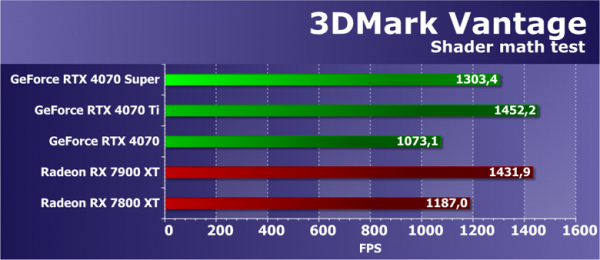
In this mathematical test, the performance of all solutions, although not entirely consistent with theory, is generally close to the maximum performance of video chips under extreme conditions. The test uses floating point operations, and it was expected that the new Ada Lovelace and RDNA3 architectures would reveal their unique capabilities in dual execution of the corresponding instructions. However, this test is outdated and is not fully capable of reflecting the new capabilities of modern GPUs, judging by the comparative results.
The weakest model of the GeForce RTX 40 Super family showed the expected results, outperforming the base model by more than 20%, which corresponds to theoretical assumptions. Both GPUs are also inferior to the older full-chip RTX 4070 Ti, although the new one comes close to matching its performance. Compared to competing Radeon models in a similar price range, Nvidia's new model again delivers speeds between the RX 7900 XT and RX 7800 XT, which is in line with expectations. Further analysis can be carried out in more modern synthetic benchmarks that more effectively test the capabilities of modern GPUs.
Direct3D 12 tests
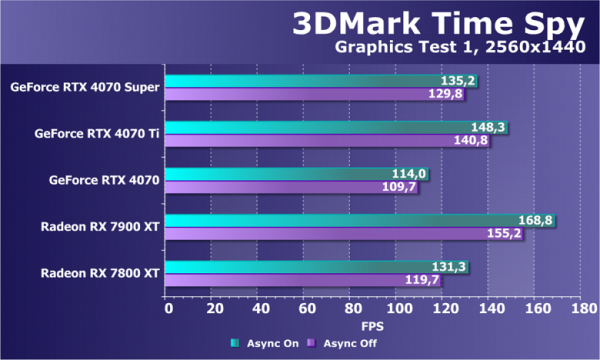

If we consider the performance of the new GeForce RTX 4070 Super model in this task compared to a basic video card based on the same GPU, but with fewer active units, we can see that the improved video card is 16%-18% superior. This is slightly lower than the theoretical difference between them, but this can be explained by the influence of other parameters. Despite the synthetic nature of the test, it measures the performance of the GPU as a whole, and not of its individual units. The RTX 4070 Ti performs stronger than expected, perhaps due to the increased maximum power consumption: 285 W compared to 220 W for the base model, which likely limits the full reveal of the new product.
All Radeons in this test generally perform better than competing GeForces at the same price, which is something to consider. This time the performance of the GeForce RTX 4070 Super video card was lower than expected. Even the more affordable Radeon RX 7800 XT showed similar results to the new product, although it was expected to be a little slower. In real-world games, the results of this test don't always correlate well with real-world performance, but they do indicate that AMD's solutions will perform slightly better in rasterized environments than in ray tracing, which we'll look at next.
Ray tracing tests
One of the earliest performance tests in the field of ray tracing is the Port Royal benchmark from the creators of the famous 3DMark series tests. This test is supported by all GPUs that support the DirectX Raytracing API. We tested several video cards at 2560x1440 resolution at various settings. Reflections were calculated using ray tracing in two modes, as well as the traditional rasterization method.
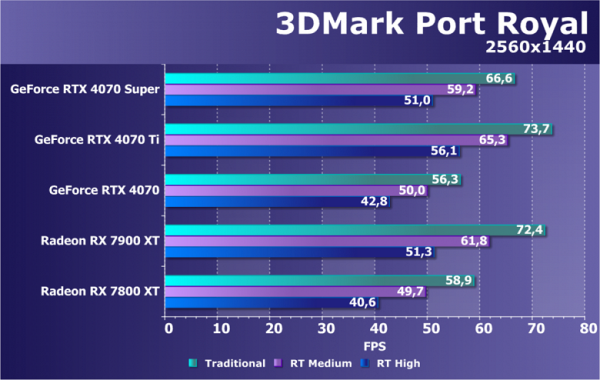
The Port Royal benchmark provides new capabilities for testing hardware acceleration of ray tracing via the DXR API. The test uses ray tracing algorithms for rendering reflections and shadows, although it is not optimized to a sufficient extent and creates a significant load, including on powerful GPUs. Nevertheless, this test is quite suitable for comparing the performance of different GPUs in a given task.
The test results clearly demonstrate the difference in the approaches of AMD and Nvidia to integrating hardware acceleration of ray tracing. Although the RDNA3 architecture slightly improved AMD's position, the new RTX 4070 Super showed the expected improvement, outperforming the RTX 4070 by 18%. Both of these models are inferior to the RTX 4070 Ti, due to the latter's higher power consumption and lack of limitations. AMD's solutions continue to handle ray tracing effectively, with RDNA3 GPUs exhibiting lower losses compared to the previous generation. Thus, the RX 7900 XT is on par with the RTX 4070 Super even with ray tracing.
Later, another 3DMark subtest appeared, specifically focused on testing ray tracing performance — DirectX Raytracing. Unlike the previous benchmark, this test is entirely dedicated to ray tracing and does not use rasterization. The scene in this test is already familiar to us from other 3DMark subtests and, being scaled, effectively demonstrates the capabilities of hardware acceleration of ray tracing of new video cards.
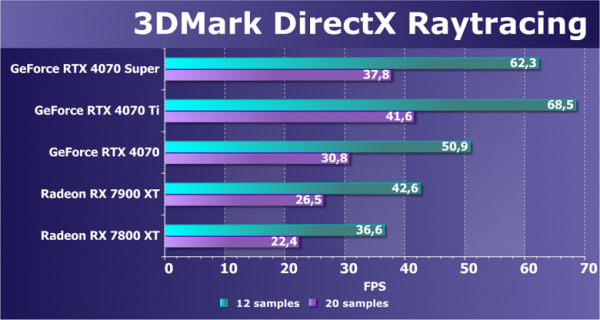
The scenario changes in the subsequent test, where almost everything depends on the speed of ray tracing. It is clear that under these conditions all GeForce video cards are significantly superior to Radeon. Nvidia's dedicated RT cores do most of the work and are more versatile in nature, without sacrificing performance when ray tracing is enabled as much as Ray Accelerator cores when combined with a competitor's regular SIMD cores. However, in most games that use ray tracing, the load on the RT units is usually lower, and the situation for Radeon is not so bad. However, in this test, Nvidia video cards continue to demonstrate a clear advantage.
The new RTX 4070 Super model significantly outperformed the base model RTX 4080, and the difference between them was 22%-23%, which was higher than expected. The speed increase in ray tracing tasks turned out to be more pronounced than in rasterization. Both options, based on stripped-down versions of the AD104 GPU, despite the lack of a full chip, are superior to all competitor solutions. Even the older Radeon was seriously inferior to the base Nvidia model, and the RTX 4070 Super turned out to be one and a half times faster. It is important to note that this is a synthetic test, and in real games this can only happen in some projects, for example, in Portal RTX, Quake II RTX, Cyberpunk 2077, Alan Wake 2 and similar ones that actively use ray tracing.
With the advent of new generations of graphics processors from Nvidia and AMD in 2022, another test with a serious load specifically on ray tracing was added to the 3DMark package — Speed Way. This test, judging by its load on various GPU units, seems more similar to widespread gaming projects that heavily use ray tracing, and is therefore of particular interest to us.

Only top-end GPUs achieve acceptable frame rates at both resolutions, and although the difference between Radeon and GeForce remains noticeable, it has decreased significantly. The AMD video cards presented in this comparison are no longer so much inferior to their conventional price competitors. The RTX 4070 Super isn't that much better than the base RTX 4070 this time around, with a difference of about 16%. The full-chip RTX 4070 Ti video card shows a slight advantage, but it doesn't pull ahead much either. It's important for us to note that the RX 7800 XT is significantly behind, and the RX 7900 XT is closing in on today's high-definition entry, where the RTX 4070 Ti is starting to fall behind in terms of memory bandwidth and memory capacity.
Let's consider another semi-synthetic benchmark, built on a real game engine. Boundary is a Chinese game project with DXR and DLSS support. This benchmark puts a heavy load on the GPU, making heavy use of ray tracing for complex reflections, soft shadows and global illumination. Naturally, we cannot use DLSS technology in Radeon tests.

4K resolution without upscaling turns out to be unplayable on all solutions reviewed. Even in Full HD resolution without using DLSS technology, only the most powerful video cards demonstrate acceptable performance. The second fastest model in the AMD line is inferior to all GeForce video cards, including the base RTX 4070, which reaches levels of more than 60 FPS. The graphics card we're reviewing today is about 20% faster than the base model, which is in line with the theoretical difference between the two. The performance of Radeon graphics cards in ray tracing tests clearly indicates that AMD solutions cannot compete with the competitor's Ada generation GPUs. The RTX 4070 Super is noticeably ahead of even the more expensive Radeon RX 7900 XT.
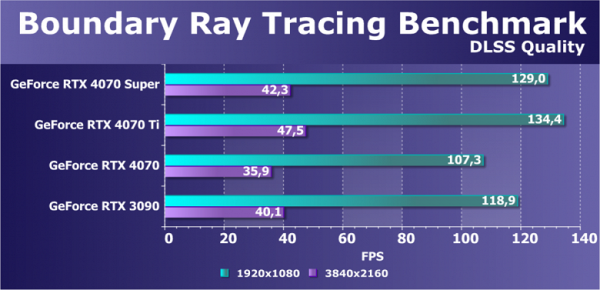
With DLSS 2 resolution scaling enabled, even the former top-of-the-line RTX 30 graphics card delivers acceptable frame rates at 4K resolution, although it doesn't reach 60 FPS, nor does the new GeForce RTX 4070 Super. The new product shows an improvement of up to 20% compared to the RTX 4070. While 4K can be played at this load, it is recommended to prefer a resolution of 2560x1440, as Nvidia recommends for this model. This will enable all maximum settings in the most resource-intensive games. The RTX 4070 Ti shows only a slight increase, which explains its withdrawal from sale.
Let's look at another semi-game benchmark, also based on a Chinese game — Bright Memory. Interestingly, both tests are similar in results and image quality, despite the different topics. However, this benchmark is more demanding, especially in terms of ray tracing performance. Unfortunately, it does not work on AMD video cards, requiring an Nvidia GeForce RTX card.
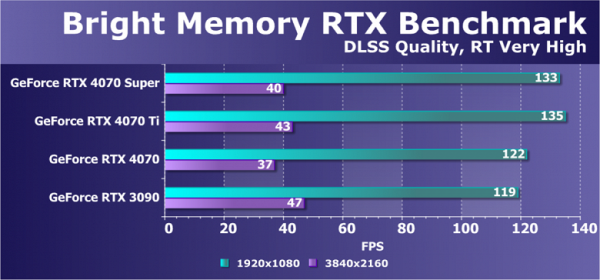
In this test, the updated Super model, based on a slightly cut-down version of the AD104 GPU, showed a result that was lower than expected when compared with the base RTX 4070. The situation in this case is different from the previous diagram. It is noticed that the RTX 3090 also shows good results, especially in high resolution. It is assumed that the influence is exerted by the memory of video cards and its volume, which are quite close for all three video cards with the 4070 index. This may explain the relative closeness of these cards' results in this test. Still, the new product showed an increase of almost 10% compared to the RTX 4070 and was even ahead of the RTX 3090, although only in low resolution.
Computational tests
We continue to look for benchmarks that use OpenCL to perform relevant computational tests to add to our synthetic testing suite in the future. At the moment, this section contains an outdated and unoptimized ray tracing test (not hardware) — LuxMark 3.1. This test, based on LuxRender and running on the OpenCL platform, is cross-platform.
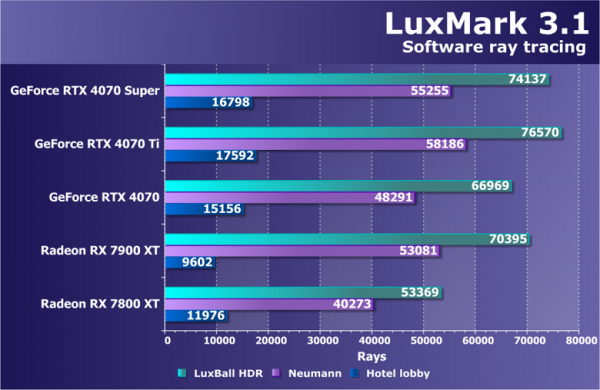
The new GeForce RTX 4070 Super model, based on an almost complete version of the AD104 GPU, has a significant number of computing units. As a result, it is not surprising that it outperformed the base RTX 4070 in this test, although the difference between the two is not as large as theoretically assumed — only 10%-11%, instead of the expected 22%. This is explained by the fact that both GPUs reach a power consumption limit that differs only by the same amount. The older model of the RTX 4070 Ti graphics card shows a slightly better result, since its power consumption limit is noticeably higher and it is rarely limited by this parameter. AMD video cards have historically been weak in this test, and even the Radeon RX 7900 XT was unable to catch up with the Super model in question from Nvidia.
Next, let's look at another GPU performance test — V-Ray Benchmark, which is also ray tracing without using hardware acceleration. This benchmark, based on the V-Ray renderer, allows you to evaluate the capabilities of the GPU in complex calculations and identify the advantages of new video cards. Previous tests used different versions of the benchmark, providing results in terms of time spent rendering and the number of millions of paths rendered per second. However, in this case we will limit ourselves to the first option.
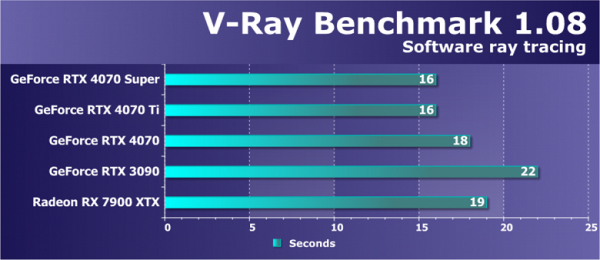
The test also included software ray tracing, and in this test the new GeForce RTX 4070 Super was not only noticeably faster than the RTX 3090 and the base RTX 4070, but was also able to match the RTX 4070 Ti. Apparently, in this case, GPU power consumption has not reached the maximum limit. However, the difference between the RTX 4070 and RTX 4070 Super is far from the theoretical 22%, perhaps due to the emphasis of software ray tracing on the speed of the cache and main video memory. Since the parameters of the intermediate data storage of video cards are similar, the results of these cards differ slightly. But it's important to note that even AMD's top-end Radeon graphics card fell by the wayside.
Let's move on to another rendering application — OctaneRender. Compatible with most 3D content creation applications, this popular renderer uses CUDA and RTX capabilities. OctaneRender 2020.1.5 now supports the Ampere architecture. A benchmark based on this renderer allows you to disable RTX acceleration and test performance in several test scenes with different loads. Unfortunately, OpenCL is not supported by this test and renderer. Below is the total number of points:
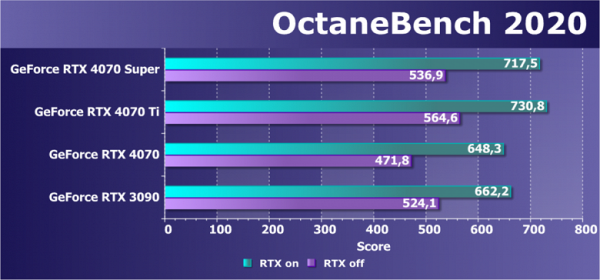
The updated GeForce RTX 4070 Super successfully outperformed the previous top-of-the-line model from the previous generation, which was expected, especially with RTX hardware acceleration enabled, which significantly improves the results of all Nvidia GPUs. The new Ada Lovelace graphics architecture benefits from improvements in ray tracing and computation. In compute tests, the RTX 4070 Super showed an 11% to 14% improvement in performance, which, while slightly below expectations, is still close to what can be expected in real-world games. It’s great that the RTX 4070 Ti is a little ahead of the new product, perhaps it’s affected by the bandwidth parameter or caching.
A new version of the popular 3D rendering benchmark, Cinebench 2024 from Maxon, was recently released. This benchmark allows you to evaluate the hardware capabilities of the processor and video card using rendering of a photorealistic scene. Cinebench 2024 is based on the 3D graphics and animation software Cinema 4D, as well as the Redshift rendering engine. CPU and GPU testing involves using the same algorithms and scenes, allowing results to be compared between processors and graphics cards.
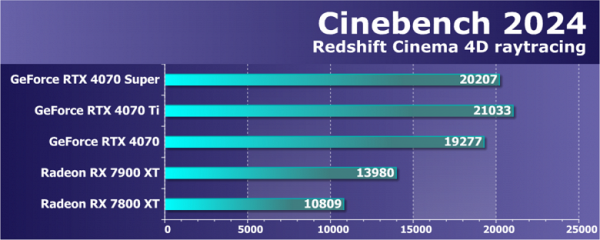
In the latest software ray tracing test, the GeForce RTX 4070 Super beat the base model, built on the same GPU but with different trim levels, by just 5%. This result is significantly lower than theoretically expected and expected. The powerful RTX 4070 Ti model, although leaving the market, is also not much ahead of the new product. It's important to note that competing Radeon graphics cards performed much worse, and it's possible that doubling the instruction rate of the new RDNA3 graphics architecture didn't work in this test, and overall performance didn't improve significantly. The younger Radeon model is significantly inferior, and the older one is also far from the new RTX 4070 Super.
Tests of DLSS/XeSS/FSR technologies
In this section, we focus on additional tests related to performance enhancing technologies. We initially looked at resolution scaling technologies (DLSS 1.x and 2.x, FSR 1.0 and 2.0, XeSS), but later we added frame generation technologies such as DLSS 3 and then version 3.5 with ray tracing reconstruction.
The first stage was the inclusion of DLSS technology testing in the materials. While we've previously run tests using the technology in ray tracing applications, we thought it would be worthwhile to conduct separate testing looking at the results of several of the company's GPUs at 4K resolution with DLSS enabled at various quality levels, including frame generation (denoted FG in the chart).
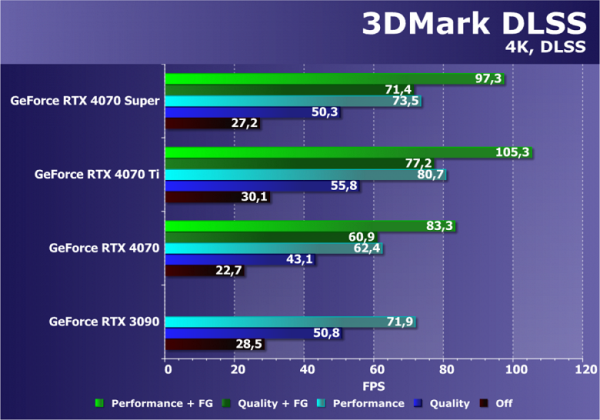
Without DLSS 2.0 enabled, rendering is performed at full resolution, which has a significant impact on performance. Video cards demonstrated only up to 30 FPS in 4K resolution, which turns out to be insufficient. However, when DLSS is activated at the maximum performance level, the frame rate becomes more than sufficient even for the top model of the previous generation RTX 3090, which does not have support for generating additional frames. The new RTX 4070 Super model demonstrated high performance comparable to the RTX 3090 and came close to the RTX 4070 Ti.
All modern Nvidia video cards of the current generation have a powerful tool — support for DLSS 3.0 technology. This technology combines the capabilities of DLSS 2.x with the generation of additional frames. DLSS 3.0 improves the smoothness of video footage with a slight increase in control latency. Enabling the generation of additional frames brings an increase in FPS by approximately one and a half times, allowing the use of higher rendering resolutions.
XeSS is another performance improvement technique that relies on rendering at a lower resolution and then upscaling the image to a higher resolution. This method, proposed by Intel, also uses artificial intelligence to reconstruct information in a frame. Unlike DLSS, XeSS works not only on Intel video cards, but also on all modern GPUs, although not as efficiently as on Intel's own solutions. For testing, a specialized benchmark from the 3DMark package was used.
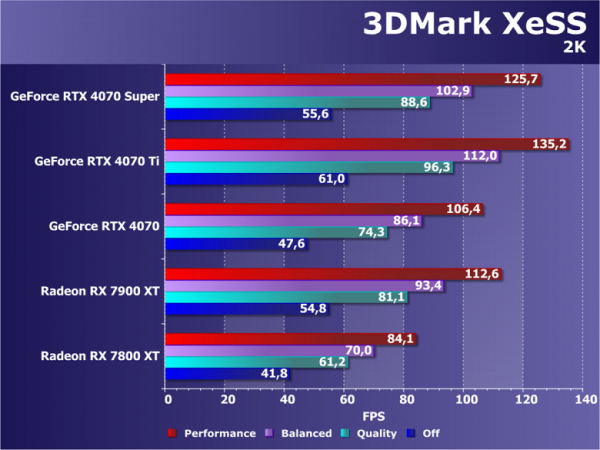
Activating XeSS results in a significant increase in frame rate — more than doubling or even more. Due to its versatility, this technology makes sense given that each of the three companies have their own technologies and acceleration blocks, but they also have their drawbacks: DLSS is the most advanced, but is limited to Nvidia devices only; FSR is the most versatile, but simple and cannot use specialized blocks for acceleration; XeSS is good and versatile, but inferior to DLSS in both quality and functionality.
In AMD's FSR 2.0 render scaling technology test, the GeForce RTX 4070 Super is noticeably faster than the base RTX 4070, which is in line with expectations. The difference between these two video cards based on modifications of the AD104 chip turns out to be significant. In this test, the Radeon RX 7900 XT and RX 7800 XT perform relatively poorly, and AMD cards generally fall behind, with the RTX 4070 Super outperforming even the more expensive solution. Probably the scene characteristics are more suitable for Nvidia solutions.
Another member of the family of rendering scaling technologies is FSR 2.0 from AMD. It’s interesting why this particular technology was included in the list of specialized subtests of 3DMark. Unfortunately, the scenes for different upscaling technologies are different, making direct comparisons difficult. We can only look at performance gains based on rendering resolution and quality, which complicates the analysis.
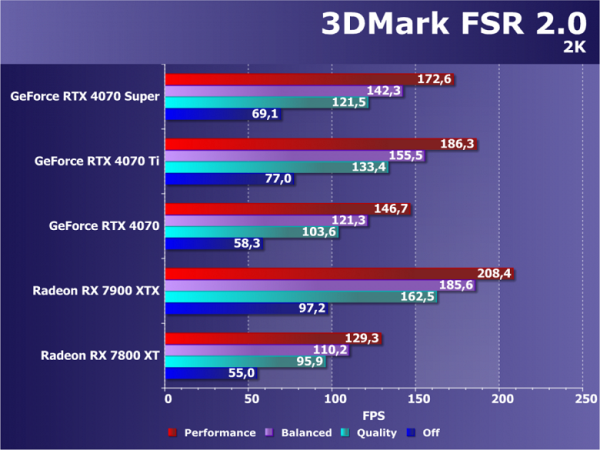
FSR is another universal technology that works almost identically on different GPUs. The FSR 2.0 tests did not reveal any particular revelations. The Radeon RX 7900 XTX (not XT, as in previous tests) performed very well, but it should be noted that it costs significantly more than all other video cards and is more comparable to the GeForce RTX 4080 Super. The new RTX 4070 Super model is close to the RTX 4070 Ti, and they are noticeably ahead of AMD's top-end graphics card, which is in line with the theory. However, the new product significantly outperforms the similarly priced RX 7800 XT model, especially in modes with various levels of FSR enabled.
Tests of scaling technologies did not reveal anything unusual, which is not surprising. The new product is noticeably faster than the base RTX 4070, thanks to a larger number of execution units, which is reflected in its superiority by tens of percent in various tests. Now let's move on to real gaming tests to evaluate how much faster the RTX 4070 Super has become than its predecessor without the «Super» index.
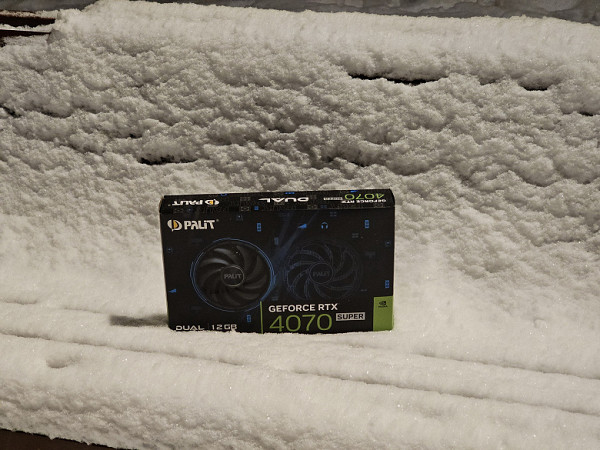
3D gaming performance in a nutshell
Before demonstrating detailed tests, we provide brief information about the performance of the family to which the particular accelerator under study belongs, as well as its rivals. We evaluate all this subjectively on a scale of seven gradations.
Games without ray tracing (classic rasterization):
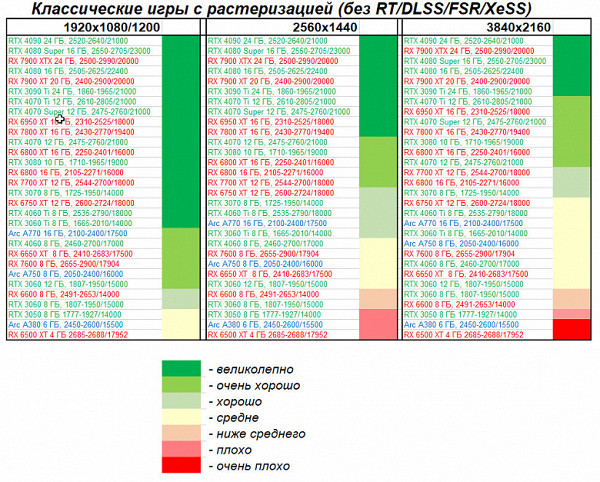
If you don’t use RT, then with the GeForce RTX 4070 Super we get excellent comfort in games at high graphics settings in all three resolutions; only at 4K in a number of complex games the comfort may be slightly lower. The GeForce RTX 4070 Super competes well with AMD products — the Radeon RX 7800 XT and the flagship of their previous generation, the Radeon RX 6950 XT.
Games using ray tracing and DLSS/FSR/XeSS:
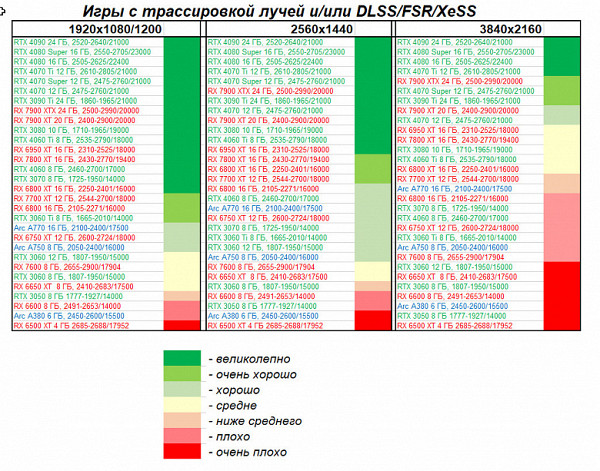
Enabling RT reduces performance, but Nvidia DLSS and AMD FSR technologies (or even Intel XeSS), already implemented in almost all games with ray tracing, greatly help compensate for the drop in speed from using RT. So, in the end, for powerful cards like the GeForce RTX 4070 Super/Ti, the previous resolution conclusions remain valid. At the same time, they even outperform AMD’s latest generation flagship, the Radeon RX 7900 XTX.
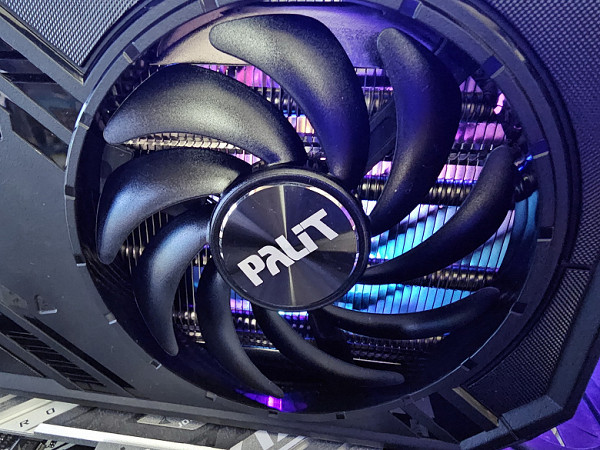
Conclusions and comparison of energy efficiency
Nvidia GeForce RTX 4070 Super (12 GB) is the junior version of the flagship line of gaming-class graphics accelerators from Nvidia. Situated between the GeForce RTX 4070 and the GeForce RTX 4070 Ti, closer to the latter, this graphics card is designed to fill the noticeable performance gap between these models. The performance differences between the RTX 4070 and RTX 4070 Ti were significant, which turned out to be unusual for graphics cards with the same base number. This phenomenon has already been encountered in previous models, such as the GeForce RTX 3060 and GeForce RTX 3060 Ti, which used different GPUs with significant differences in characteristics.
With the current generation GeForce RTX 30, Nvidia decided not to fill this gap, preferring to avoid such differences in the face of a general shortage of video cards. However, in current conditions, after the post-pandemic IT market has stabilized, not only a significant difference in performance is visible, but also in cost between the GeForce RTX 4070 and GeForce RTX 4070 Ti. Thus, the appearance of the GeForce RTX 4070 Super was a response to a market request, providing an intermediate solution for a more balanced choice.

At the time of preparing our review, sales of the GeForce RTX 4070 Super had already begun; we draw conclusions based on real price tags from marketplaces.

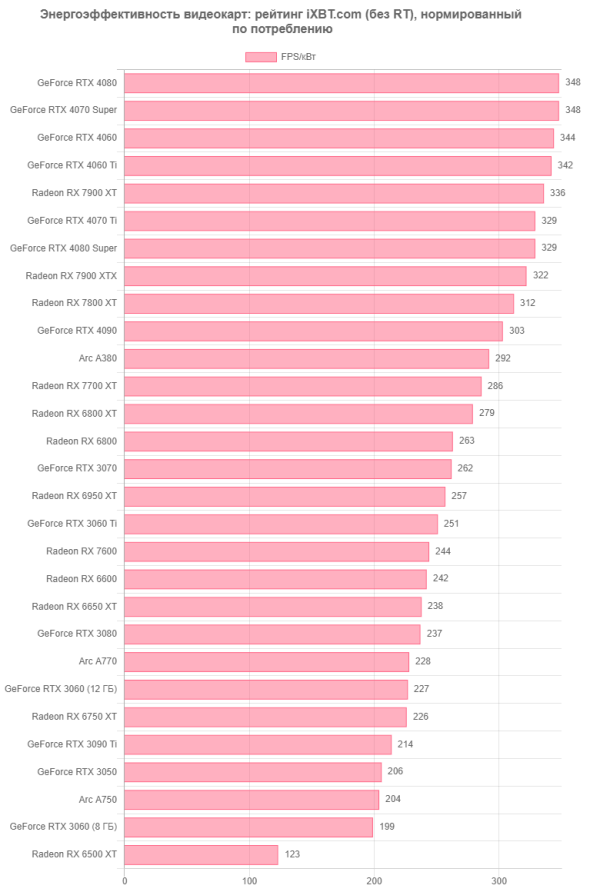
The GeForce RTX 4070 Super (12GB) delivered the second most energy efficient performance in both classic games and games with RT and upscaling enabled. This fact is a commendable result for a new product. The overall conclusion emphasizes that the top-end video cards of the latest generation are highly energy efficient, significantly superior to models of the same level from previous generations GeForce RTX 30 and Radeon RX 6000. When directly comparing the AMD and Nvidia lines in the fight for energy efficiency, the clear dominance of the GeForce RTX 40 is visible.
The Ada Lovelace architecture on which the GeForce RTX 40 is based brings major improvements to the execution units compared to the previous generation of Ampere, especially in the area of hardware ray tracing. In addition, DLSS version 3 is an exclusive addition, combining the resolution scaling from version 2 and frame rate doubling with cross-frame insertion through the optical flow field. HDMI 2.1 support, hardware AV1 decoding, RTX IO technology for fast data transfer, and the ability to output 4K at 120 FPS or 8K with a single cable make the RTX 4070 Super technologically advanced.
Despite these advantages, the DisplayPort standard is limited to version 1.4a, while competing Radeon RX 7000 graphics cards already support DisplayPort 2.1 UHBR13.5, which gives them the advantage of delivering high-resolution images without streaming compression. The tested model Palit GeForce RTX 4070 Super Dual (12 GB) has a compact size, an efficient cooler and consumption of up to 220 W, requiring one 16-pin PCIe 5.0 power connector.
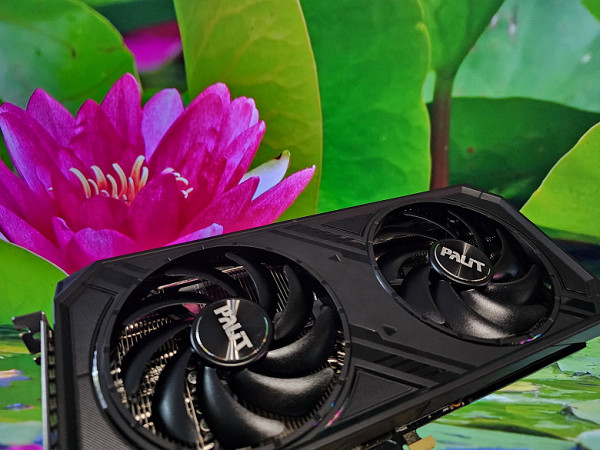
The manufacturer provides a 3-year warranty for this video card.
We emphasize once again that the GeForce RTX 4070 Super is ideal for gaming at resolutions up to 4K with maximum graphics quality in traditional games without ray tracing. In the most graphically demanding games, the comfort level may be slightly reduced at 4K resolution.
The GeForce RTX 4070 Super is also great for ray-traced games that support DLSS/FSR/XeSS technologies, providing high comfort at 1080p and 1440p resolutions. To achieve the same level of comfort at 2160p (4K), the game will need support for DLSS 3 technology. If the game does not support ray tracing technologies, then the comfort zone will be limited to 1440p (2.5K).

